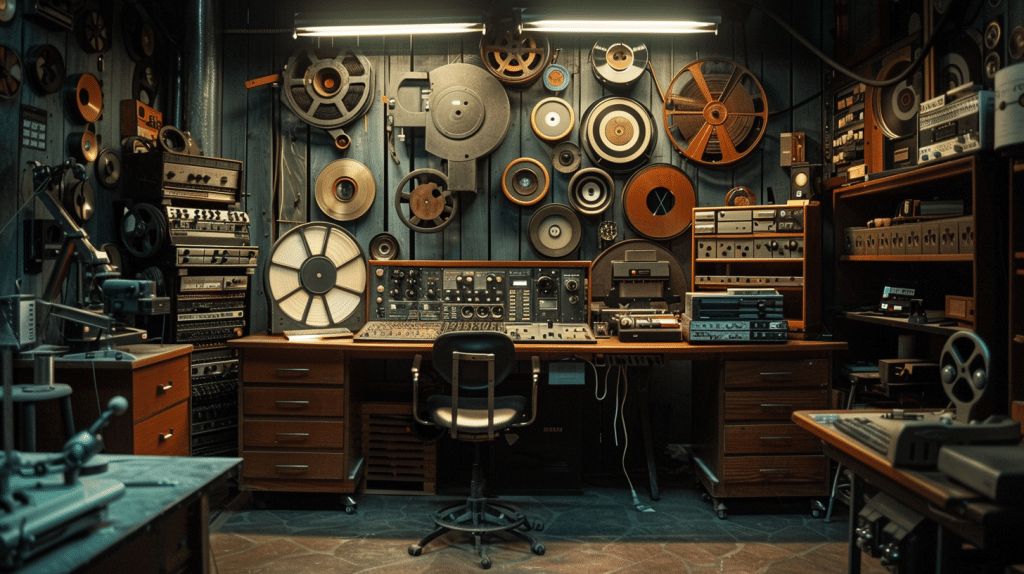Cut! The Art and Evolution of Editing

The shift from analog tapes to digital technology has revolutionized the landscape of film editing, ushering in a new era of efficiency and creativity.
This transformation not only marks a departure from the laborious manual splicing of physical film but also signifies a significant leap forward in the domain of visual storytelling.
As professionals adapt to these advancements, the question arises: how has this evolution reshaped the very essence of cinematic narratives and the role of the editor in shaping them?
Transition From Manual Splicing
The shift from manual splicing in film editing represents a significant change in the industry’s technological advancement and workflow efficiency.
Manual splicing, involving the physical cutting and piecing together of film strips, required meticulous attention to detail and a hands-on approach. This traditional method demanded skill and precision, with each edit being a deliberate and irreversible decision.
However, with the advent of digital editing on computers, the process has become more streamlined and efficient. Digital editing allows for quicker revisions, non-destructive editing, and easier collaboration among team members.
While manual splicing had its charm and tactile experience, digital technology has revolutionized the editing process, offering greater flexibility and enhancing the overall productivity of editors.
Impact of Digital Technology
Digital technology has profoundly transformed the landscape of film editing, revolutionizing workflows and enhancing creative possibilities.
The shift from physical tapes to digital platforms has streamlined the editing process, allowing for greater flexibility and efficiency.
Editors now have access to a wide array of tools and effects that were once unimaginable, enabling them to bring their creative visions to life with precision and ease.
The ability to manipulate footage with precision, experiment with different cuts effortlessly, and seamlessly integrate visual effects has greatly expanded the horizons of film editing.
Additionally, digital technology has made collaboration between editors and other professionals more accessible, facilitating smoother workflows and fostering greater creativity in the editing process.
The Art of Film Editing
Film editing is a meticulous craft that intricately weaves together visual and auditory elements to shape the narrative and evoke emotions within the audience.
Professional editors play a vital role in this art form, utilizing their experience and expertise to transform raw footage into a cohesive and impactful story.
By skillfully arranging scenes, adjusting pacing, and enhancing audiovisual elements, editors guarantee a seamless flow that captivates viewers.
The art of film editing extends beyond technical proficiency; it requires a deep understanding of storytelling techniques and the ability to evoke specific emotions through creative choices.
Through their mastery of the craft, professional editors elevate the quality of a film, enriching its narrative and leaving a lasting impression on the audience.
Evolution of Professional Editing
Film editing has undergone a significant transformation in the professional domain, adapting to technological advancements and altering the landscape of storytelling through visual media.
Professional editors now harness digital tools for editing, moving away from manual cutting and splicing of film. This shift has enabled quicker editing processes, though some argue it may lead to a potential disconnect from the project.
Despite this, the essence of good editing as an art form remains unchanged, requiring experience and expertise.
Professional editors play an essential role in problem-solving, storytelling, and staying abreast of the latest editing technologies.
Their ability to create polished visuals, refine audio, and efficiently compress videos distinguishes their work and guarantees high-quality results within project deadlines.
Benefits of Professional Editing
Professional editing services offer invaluable advantages that enhance the quality and impact of visual storytelling projects.
Professional editors bring a wealth of experience, guaranteeing seamless storytelling and problem-solving.
Their expertise in utilizing the latest editing technology results in polished graphics, enhanced audio, and efficiently compressed videos.
By entrusting projects to professional editors, time is saved, as they navigate complexities adeptly without the need for extensive research.
The refined skills of professional editors make certain that the final product is of high quality, loads quickly, and maintains its integrity.
Skillman Video Group editors exemplify proficiency in cutting-edge editing techniques, delivering superior results within set deadlines.
Choosing professional editing over DIY approaches ensures a professional touch and elevates the overall production value.
Share:
Search our blog:
Follow us on:
